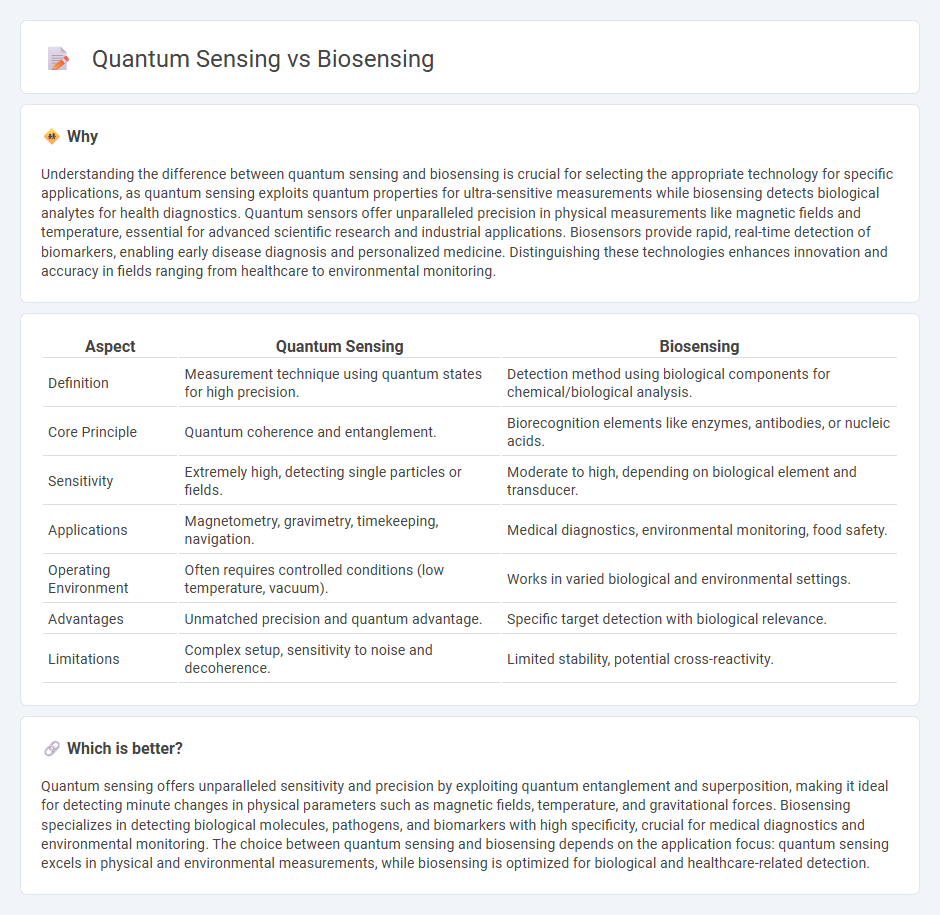
Quantum sensing leverages quantum phenomena such as superposition and entanglement to achieve unprecedented sensitivity and precision in measuring physical quantities like magnetic fields, temperature, and time. Biosensing uses biological molecules or systems to detect chemical or biological substances, enabling applications in medical diagnostics, environmental monitoring, and food safety. Explore further to discover how these cutting-edge sensing technologies revolutionize accuracy and detection capabilities across diverse fields.
Why it is important
Understanding the difference between quantum sensing and biosensing is crucial for selecting the appropriate technology for specific applications, as quantum sensing exploits quantum properties for ultra-sensitive measurements while biosensing detects biological analytes for health diagnostics. Quantum sensors offer unparalleled precision in physical measurements like magnetic fields and temperature, essential for advanced scientific research and industrial applications. Biosensors provide rapid, real-time detection of biomarkers, enabling early disease diagnosis and personalized medicine. Distinguishing these technologies enhances innovation and accuracy in fields ranging from healthcare to environmental monitoring.
Comparison Table
| Aspect | Quantum Sensing | Biosensing |
|---|---|---|
| Definition | Measurement technique using quantum states for high precision. | Detection method using biological components for chemical/biological analysis. |
| Core Principle | Quantum coherence and entanglement. | Biorecognition elements like enzymes, antibodies, or nucleic acids. |
| Sensitivity | Extremely high, detecting single particles or fields. | Moderate to high, depending on biological element and transducer. |
| Applications | Magnetometry, gravimetry, timekeeping, navigation. | Medical diagnostics, environmental monitoring, food safety. |
| Operating Environment | Often requires controlled conditions (low temperature, vacuum). | Works in varied biological and environmental settings. |
| Advantages | Unmatched precision and quantum advantage. | Specific target detection with biological relevance. |
| Limitations | Complex setup, sensitivity to noise and decoherence. | Limited stability, potential cross-reactivity. |
Which is better?
Quantum sensing offers unparalleled sensitivity and precision by exploiting quantum entanglement and superposition, making it ideal for detecting minute changes in physical parameters such as magnetic fields, temperature, and gravitational forces. Biosensing specializes in detecting biological molecules, pathogens, and biomarkers with high specificity, crucial for medical diagnostics and environmental monitoring. The choice between quantum sensing and biosensing depends on the application focus: quantum sensing excels in physical and environmental measurements, while biosensing is optimized for biological and healthcare-related detection.
Connection
Quantum sensing enhances biosensing by utilizing quantum properties like entanglement and superposition to achieve unprecedented sensitivity in detecting biological molecules and processes. This connection enables breakthroughs in medical diagnostics, allowing for early disease detection at the molecular level. The integration of quantum sensors with biosensing technology promises significant advancements in health monitoring and personalized medicine.
Key Terms
**Biosensing:**
Biosensing leverages biological elements such as enzymes, antibodies, or nucleic acids to detect and quantify analytes with high specificity and sensitivity, commonly applied in medical diagnostics, environmental monitoring, and food safety. Advanced biosensors integrate nanomaterials and microfluidic technologies to enhance signal transduction and enable real-time, point-of-care analysis. Explore the latest innovations in biosensing technology to understand its growing impact across health and environmental sectors.
Biomarker detection
Biosensing for biomarker detection leverages biological elements like enzymes or antibodies to identify specific molecules with high selectivity, enabling rapid diagnostics and monitoring of diseases. Quantum sensing utilizes quantum phenomena such as superposition and entanglement to achieve ultra-sensitive detection of biomarkers at the molecular level, often surpassing classical sensor limits in precision and speed. Explore the latest advancements in biomarker detection techniques to optimize diagnostic accuracy and healthcare outcomes.
Electrochemical transducer
Electrochemical transducers in biosensing leverage biochemical reactions to generate measurable electrical signals, enabling high sensitivity in detecting biological analytes. Quantum sensing utilizes quantum properties such as superposition and entanglement to achieve superior sensitivity and resolution beyond classical limits, enhancing detection of electrochemical changes at the molecular level. Explore the advancements in electrochemical transducers to understand how quantum sensing is revolutionizing biosensor technologies.
Source and External Links
Biosensor - Wikipedia - A biosensor is an analytical device that combines a biological component with a physicochemical detector to identify chemical substances, transforming biological interactions into measurable signals.
A short review on cell-based biosensing - Cell-based biosensors use engineered cells, often with optogenetic controls, to detect analytes rapidly by monitoring changes in cellular electrical activity or membrane potential without the need for reporter protein expression.
Biosensors for Public Health and Environmental Monitoring - Biosensors are vital tools for detecting pollutants, pathogens, and toxins in environmental and public health settings, with advances like single-molecule detection offering high sensitivity and specificity for rapid screening.
 dowidth.com
dowidth.com